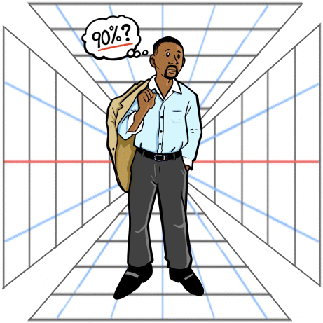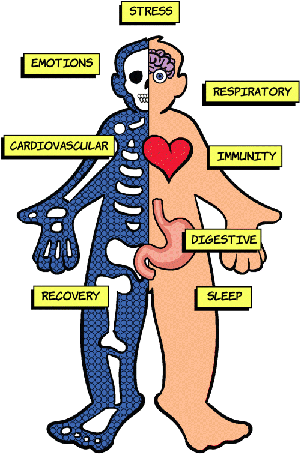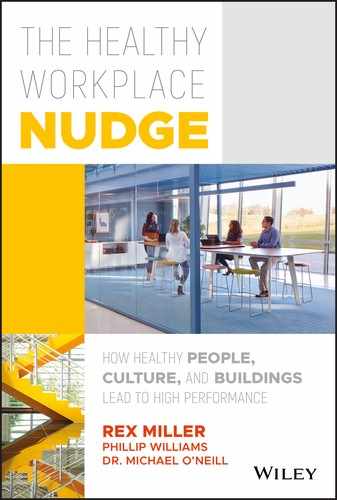Chapter 10
The Healthy Building Nudge: The Invisible Power of the Workplace
The messages encoded in architecture and systems can foster a sense of mastery or helplessness.
—Charles Montgomery1
Ron Goetzel is the senior scientist and director of the Institute for Health and Productivity Studies at the Johns Hopkins Bloomberg School of Public Health. When I interviewed him, he explained why most companies just cannot pull off the creation of a healthy culture:
It is very, very, very, very hard to change human behavior. The way to get there requires a combination of different activities…culture, physical design, incentive programs, communication dissemination, strategic thinking about how to do that and expertise in the science of behavior change.
All of those things are woven together, and most companies in America don't know how to do that. They don't have the expertise, they don't have the background, they don't have the knowledge. Many don't have the money.
So, how do you create a culture of happiness and health?
Let's get started on the answer by stepping into another interview. I have learned that when Al Lewis speaks, you really don't want to miss anything. So, when he recently summarized the best corporate approach to wellness, I leaned in and listened very intently: “If I led a company with a lot of employees, I would spend money on environment rather than spend money telling them to change their bad behaviors. It's not even a question. If someone's environment is going to dramatically impact their health, productivity, and retention—that is where I would focus.”2
So, why, despite the invaluable perspectives of Lewis, Goetzel, and so many others, are most companies and organizations still trying to “do wellness” by requiring change at the individual employee level? That is not only futile, it is also very expensive. Because of our 18 months of research, I can tell you that improving the physical environment will prove to be a more effective and economical path to improving health than trying to force people to adopt behaviors which are in the best interests of their own physical being.

Figure 10.1 Money is wasted on ineffective wellness programs.
We found the best companies had two things in common; (1) committed and engaged leadership and (2) they invested the time and hard work to build healthy cultures. We know that leadership is the key. But without the hard work of building a robust ecosystem to support the leader's conviction, commitment, and congruence, those efforts become beautiful sandcastles that wash away under the next regime, budget squeeze, or market drop.
Just 5% of companies have the committed leadership and the necessary support structures and culture to nurture and protect employee health and well-being. So we think it's important to find a strategy that works for the 95%. When we concluded that most wellness programs are ineffective and a waste of money, we faced the question: What's the alternative? We believe it starts in designing healthy buildings.
Begin with a Healthy Building—A Slam Dunk!
Every time I meet with Paul Scialla, I learn new wisdom about our lives in a walled world. In each conversation, I hear three consistent themes.
- Our species is still trying to adapt to living—90% of our time!—indoors.
- The immediate space that surrounds us carries positive and negative health implications.
- We have the ability, at a relatively low cost, to eliminate the harmful effects of buildings and transform them into delivery systems of health.
When I first met with Paul, he shot straight to his first point.
Look at your built environment, where you spend 90 percent of your time. Take your age, multiply it by 0.9. That's how much of your life you have lived inside of four walls and a roof. What if we could activate that space to provide a passive and constant delivery of preventative medical benefits that wouldn't require the occupant to do a thing? An individual, just by being in the space, whether at home, office, or school…just being in that space could have positive exposure to cardiovascular health, respiratory health, immune health, sleep health, cognitive health. This is a slam dunk!

In the past few years, the International Well Building Institute,3 FitWel,4 the Living Building Challenge5, Blue Zones6 have distilled the best research into accessible information and guidelines. All corporate HR directors, wellness managers, heads of safety, corporate real estate executives and all those in the building service/supply chain should become familiar with the research. For the first time, we have a bridge of common language, which will help us move the discussion from building sustainability to human sustainability.
How Can a Building Make a Difference?
Paul Scialla imagines a day, in the not too distant future, “When our phones or wrist devices will warn us about toxic VOC's or unhealthy CO2 levels. Your phone could tell you that the EPA reports exposure inside a building is up to five times more toxic than standing outside. It's all coming, but we can do something now. The cost of designing healthy buildings is marginal. A 1% add to construction, and even that will become zero in the next few years.”
So, what was he talking about?
At its core, a healthy work environment can be considered a useful and competitive business strategy to retain employees for the long-term.
—Jessica Nicolosi, Master's thesis, “A Holistic Approach to Workplace Wellbeing”
The following summaries of our 11 body systems give a brief glimpse into how our places of work influence our health, well-being, and performance. For most of my career, I had evaluated buildings through an environmental and aesthetic lens. But that view misses the deeper relationships between body, mind, and place. After examining the research, I came to an “aha” moment: “Of, course our environments deeply impact us, how could it be any other way?” At the very least we should build spaces that “do no harm.” At their best, buildings can become invigorating and inspiring—with little additional expense.
You will see in these summaries that spending on your building is the place to begin if you want to achieve serious improvement in the health and well-being of your employees. As you read, remember that stress is a dominant factor in our ability to function. Buildings have enormous potential to improve lives through supporting greater health for these systems:
- Cardiovascular: Sitting decreases the heart rate and blood flow, sending less oxygen through your body. Movement raises metabolism and flushes the stress hormone, cortisol, out of the body. Buildings can be designed to reduce environmental stressors (noise and distraction) and with nudges to increase movement.
- Digestive: Eating properly helps your body recover. Relaxed eating, especially with friends, activates the parasympathetic nervous system, releasing dopamine (pleasure) and oxytocin (connection). Eating while working, alone, or in noisy or crowded conditions places our nervous system on guard; it stands vigilant against real or imagined threats. Building design can create the pleasant spaces and communal connections that lower stress.
- Endocrine: The endocrine system regulates metabolism, immunity, mood, and digestion. Maintaining balance is key to reducing chronic disease. Daylight and circadian lighting curtail endocrine disruption and stress.
- Immune: Our immune systems often overload from fatigue and stress. That results in poor sleep and susceptibility to viruses, disease, and metabolic syndrome. Proper building design and construction can reduce environmental stress and exposure to toxic materials and chemicals that overload our immune systems. Buildings can also provide recovery areas that nudge people to take short breaks, further decreasing stress.
- Integumentary: This largest human body system provides our external protection and works with the immune system to ward off an attack. Building design can help by regulating body temperature, providing hydration, and reducing exposure to toxins.
- Urinary: Building design plays an important role supporting our body's primary system for removing toxins. The reduction of stress, healthy food selections, and engaging hydration stations provide some of the nudges to keep the body cleansed.
- Reproductive System: Stress, toxic materials, chemicals, and electromagnetic fields all affect our reproductive system, balance, and mood. Buildings that provide easy and abundant access to nutritious food and adequate hydration contribute to improving reproductive health.
- Muscular: Building design plays a major role in allowing safe movement. Ergonomics for support and environmental nudges to move are key to maintaining muscular tone and flexibility, thereby removing the cause of neck, shoulder, and back pain.
- Skeletal: In its role as “body armor,” the skeletal system protects the organs and the nervous system, produces blood cells, and regulates hormones. Ergonomic design can help to lessen the muscle fatigue and stress that can lead to injury.
- Respiratory: Building design can improve CO2 levels; limit toxins, molds, and microbes; reduce particulate matter, and nudge people to more activity.
- Nervous: The nervous system includes both cognitive and autonomic functions. The Academy for Neuroscience in Architecture at the Salk Institute helps companies to apply the latest research in neuroscience to “human responses in the built environment.”

Figure 10.3 The workplace environment affects most systems of the body.
Shari Barkin, division chief of general pediatrics at Vanderbilt University Medical Center, told me how buildings influence our health and well-being from childhood:
You're actually building your reactions to your environment during the critical windows of development in childhood. Buildings set your stress response and your reactions to certain things in your environment. That gets amplified over time. If you've created an environment that's more stressful, you're developing a physiology that's very reactive to stress. This pushes you in the direction of chronic illness.
“Let's Design a Better Planet!”
Whitney Gray, executive director of research and innovation at Delos, began her career in public health by focusing on domestic violence. After receiving her PhD from Johns Hopkins in health policy, she became a professor of nursing health studies. She was still searching for her purpose path when she saw the 2002 documentary The Next Industrial Revolution.7 Susan Sarandon's voice opens the documentary: “Sustainable economy: an economic system that meets the needs of its current members without compromising the prospects of future generations.”
Whitney saw a possibility beyond the film's message, a sustainable planet as the foundation for social justice and sustainable health. She kept looking for her place, the planetary spot that would release her to do that. When she met Paul Scialla, she knew she found a home. At the end of their first conversation, she said, “Let's design a better planet!”
When she presented to our group during our summit at Kaiser Permanente's Washington, DC, Center for Total Health, her natural intensity hit us hard. She rolled right into a forceful look at the ways humans have shifted natural rhythms, relationships, orientation to time, and definitions of home and play since buildings became a dominant influence in our lives. Her presentation certainly raised the question of why, if we spend 90% of our time in built environments, do we not also spend 90% of our focus and funds on buildings?
When asked how much the new WELL standards would add to construction, Phil Williams, Delos president of business, told our team, “CBRE was our first commercial office project and so far, the most expensive. CBRE spent an additional 1.73% on the WELL upgrades. We're finding the cost premium can be $0. The average is about half of CBRE's cost.”8
Lew Horne once told me, “Our WELL Building Certification is a tangible way for us to let our employees know we value them. As soon as they get off the elevator, they see the emblem. They know what we did. The certification is a simple reminder, but the space is the big reminder. Not a week goes by when I don't get a thank you.”
How will we measure success in sustainability and wellness? Hopefully, the generation born today will wonder why we ever needed certification programs and ordinances to ensure energy efficient and healthy work environments.
—Dean Stanberry
Lew is emphatic when describing how their Los Angeles headquarters project transformed the behavior in the office, the lives of employees, and even their business. A change of space was a catalyst for a change in culture. He believes their process made the difference. They had no precedents and no best practices to serve as guides. It was a risky endeavor, but it created room to explore new ways of thinking and working. Lew recruited close to 25% of the office, working in small teams, to research technology, furniture, art, food, converting paper to the cloud, culture, move logistics, furniture, etc. Their Friday afternoon recaps were conducted in front of a full-height project learning wall. That provided a simple way to discuss what was, or was not, working. The weekly open meetings kept the teams aware of how the different aspects of the project were evolving and how to synchronize the work as the vision continued to take shape.
The process sometimes clashed with the linear prescriptive process from some of their consultants. We call that a design shift from PUSH to PULL. The old approach of PUSH is too cumbersome—have you ever pushed a chain? And it is too expensive to bring in experts in each category and expect them to play well together. The PULL process addresses integration challenges as well as creating a solution to uniquely fit an organization's needs.
In summary, PULL is like playing in a jazz band; PUSH is plodding through a checklist.
PUSH assumes:
- Leaders or experts have the answers (“Trust the expert”).
- Leaders can accurately plan results.
- Achieving results is based on a “proven” and often proprietary path.9
PULL assumes:
- Leaders should challenge assumptions with fresh questions; they should trust the process.
- Leaders invite stakeholders into the process of discovery and testing.
- Achieving results is based on evidence gained from discovery and testing.
Your Workplace Is a Proxy for Your Health and Well-Being
Delivering a healthy building and one that transforms your culture and business may sound daunting, but is very achievable, increasingly necessary, and surprisingly economical. The largest catalyst to understanding and transforming our organizations is literally under our feet. When an organization thinks about changing their workspace, that very idea raises fundamental questions, excavates old assumptions, and causes everyone to roll up their sleeves to understand and rediscover “why we do what we do.” Solutions that rise out of that process bring transformation.
Our workspaces send powerful messages about what our organizations value. Lew Horne explained that his employees walk in each day, see their WELL certification, and know that means something:
I think the WELL certification speaks to employees knowing we built this space with their health in mind. Our space is also having a positive effect on the home front. I hear employees talk about how they are eating differently at home, or becoming more active. We are in the building business. We believe buildings make a difference, but I have not seen anything quite like this before. It is also helping us with our clients. Because we've gone through our own journey, and it's made a huge difference for us, our clients seem to sense we can do the same for them.
Let There Be Light!
The WELL Building Standard lists more than 100 health issues. Let's look at one, just one, feature to examine—light. This one area will give us a lens for viewing how buildings can contribute to greater employee happiness and health.
Maybe the reason I resonate to the subject of light is that my father graduated from Rochester Institute of Technology, specializing in reprographics. So, I grew up hearing and knowing about light frequencies, UV waves, additive and subtractive lighting. Light is a magical essence that invades our bodies with electromagnetic radiation, influencing both happiness and health. Light plays a profound role in physical and mental health.
The sun, in its daily or circadian cycle, regulates our biological clocks. Body temperature and cortisol elevate during the morning hours, responding to the rising blue light spectrum. But body temperature decreases and melatonin elevates to prepare us for sleep. That's why light is such a significant health issue. As the WELL Building Standard reminds us, “Given that people spend much of their waking day indoors, insufficient illumination can lead to a drift of the circadian phase.”10
During an interview with Paul Scialla, I noticed a light fixture I had not seen before. I asked him about it. Now, understand, asking Paul a simple question ignites his authentic curiosity. He confidently gazes at objects, people, and ideas as a genuine seeker of knowledge. As he seeks, he talks.
“Forget the fixture. You see that lighting? It's a very high-lux temperature light. It's supposed to match the sky. It's doing that for a reason. We are conditioned to be outside, active, energized, and mentally acute during the day, and asleep at night. That's stems from tens of thousands of years of biological history. That was until we created these little boxes around ourselves; now we spend 90 percent of our day inside. Even more disruptive, 100 years ago we invented artificial light, and for the first time, the human body was exposed to artificial light in the evening. That completely disrupted our natural circadian rhythm.
“The more we can match lighting to what we're supposed to get outside during daytime and adjust to a softer yellow and lower lux light in the evening, the more we're going to have the right hormones created in the evening for sleep and in the daytime for activity.
“Do you know there is a nerve in our eye that was only discovered nine years ago? It's called the circadian optic nerve. It is the first time medical science has realized there's a mechanism in your eye that has nothing to do with vision. It takes in peripheral light and darkness and controls your sleep-wake cycle. That's it.

“We can extend the workday in a very healthy manner by applying higher lux, higher temperature, bluer, brighter, whitish light in an office setting to keep the body stimulated like it was still early afternoon, to keep mental acuity hormones and productivity hormones elevated, and stop the early secretion of melatonin. If you're already making a lighting decision, if your facility's manager is doing an LED swap, the health attributes of lighting can have a profound impact on the bottom line of the company. That could extend and enhance productivity for a couple hours a day for three months out of the year. That's your upside calculation. That additional performance factor comes at zero cost. The ROI for a simple swap is infinity.
“I installed circadian lighting in my bedroom. It's dynamic. It basically changes and creates the sunrise, midday, late-afternoon, early evening, and evening light inside.”
Artificial light, and especially blue spectrum light, may be the single most harmful assault on our minds and bodies. Providing circadian lighting and harvesting natural light may also be the easiest, least expensive, and most immediate with the highest positive impact investment on 100% of your employees.
New York Times Building—The Magical Effect of Light
I met David Thurm in early 2008, about six months after the New York Times moved into their iconic headquarters. As the senior vice president of operations and in charge of the project, David had two design objectives for the building:
- Lowering operational cost
- Improving employee experience and health
He came away from two previous building projects with a guideline: “Push the limits on what you hope to deliver to employees: it's worth it.” To push the limits on their project, the “gray lady” was forced to step outside its traditional role as a purchaser of goods and services to partner with key suppliers and push their limits.
That collaboration led to a most interesting feature in the building, a digital adjustable lighting interface (DALI). The building is designed to harvest as much natural light as possible. Expanding windows to let the sunshine in was the easy part. Tuning the space to manage glare, changing light conditions and hot spots, required very precise science. The building coordinates indoor and exterior conditions to optimize natural light and mimic the pattern of the sun. Three roof-mounted radiometers track the sun throughout the day. The signal is then processed through an algorithm to automatically adjust the exterior shades and internal lights. Mirroring the circadian rhythm may, perhaps, be the biggest health breakthrough in building technology.
In 2003, five years before the project, they hired Lawrence Berkeley National Laboratory (LBNL) to advise them on the project. In 2011, three years after project completion, they brought LBNL back to measure both building and human performance factors. That level of pre- and post-occupancy research reveals the level of intentionality that is essential for creating healthy buildings. Steven Selkowitz's “Daylighting The New York Times Headquarters Building" provides the full report.11
That report documents the significant energy and cost savings they had hoped to see. It also confirms that 78% of the occupants were highly satisfied with the lighting experience.12 David reminded me of the business conditions in 2011:
We had just gone through another round of layoffs, people were understandably on edge and upset, but our satisfaction levels for the office simply confirm what we thought at the beginning of the project: our workplace could become something special and meaningful to our employees. I had the chance to visit the building earlier this year. The way natural light is captured in that space is still simply magical.
The Bridge to a Happy and Healthy Workplace
The first time I visited CBRE, I stepped off the elevator onto a cork underfloor (ah, the cushioned lumbar support). When I entered the open lobby, I was greeted by their concierge/receptionist. To her left, I saw a long, standing-height countertop. It displayed a healthy drink area and a several drawers filled with healthy snacks. Darcy, my tour guide, walked down the large central staircase; it was obviously designed to invite use. We entered a soft seating living room area called “The Hearth.” Next, on the tour, we looked in on the nutrition and yoga classroom.
The CBRE office is divided into “neighborhoods.” Employees can sit wherever they want, but tend to work in “their” neighborhood. Neighborhoods include a suite of glass-walled privacy offices, conference rooms, and low-height, open stations along the windows. Every station includes an adjustable sit-to-stand surface and two monitors with adjustable support arms. Darcy pointed out the circadian lighting and how the shades and light adjust over the workday. She explained that surface tops have antimicrobial laminates and each evening the office is cleaned using a UV wand with detailed cleaning protocols. Employees who chose to stand were given standing pads. The office is very open, but the distractions of noise are kept low, using sound-dampening materials and sound-masking equipment. Hydration stations serve purified water that meets WELL specifications. Their food areas displayed fresh fruit, nuts, and other healthy snacks. The last item I saw was the indoor biophilia landscaping.
Do you know what message speaks clearly to anyone walking through the office? That CBRE values health and their employees. Do employees feel that way about your company? Do they know the company cares? The CBRE project was a first of its kind, and the cost for its stunning upgrades was only about 1.73% more than normal construction. And that cost is coming down.
Paul Scialla is passionate about helping Delos customers “unlock human potential through your building.” The best way to lift the health and well-being of your employees is to invest in the very place where they spend so much time. By doing that, instead of building complex and expensive behavior modification strategies that actually benefit very few, you can improve the lives of 100% of everyone who enters your built environments.
